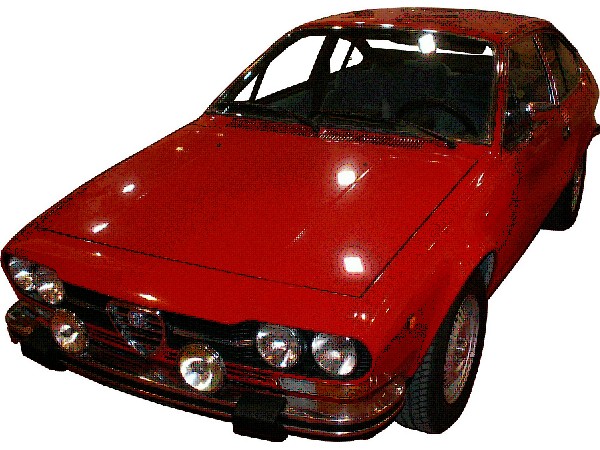|
|
|||||||||||||||||||||||||||||||||||||||||||||||||
| |||||||||||||||||||||||||||||||||||||||||||||||||
|
|
A B C D E F G H I J K L M N O P Q R S T U V W X Y Z
| ||||||||||||||||||||||||||||||||||||||||||||||||
| Alfetta GT | |
| Engine | In-line four-cylinder |
| Displacement | 1570/1779/1962 cm³ |
| Bore * stroke | 78/80/84 * 82/88,5/88,5 mm |
| Engine control | DOHC (timing chain) |
| Mixture preparation | 2 dual carburetor |
| Torque | 142/167/176 Nm at 4300/4400/4000 rpm |
| Power | 79/90/96 kW (109/122/131 HP) |
| Nominal rotation speed | 5600/5500/5300 rpm |
| Design | Front engine - transaxle, rear clutch and transmission |
| Transmission | Manual five-speed |
| Suspension (front) | Double wishbones and torsion bar springs |
| Suspension (rear) | De Dion-axle |
| Brakes | Discs, (rear) inboard |
| Wheelbase | 2400 mm |
| Tyres | 185/70 HR 14 |
| Design | Centro Stile |
| Drag coefficient | 0,39 |
| Tank capacity | 54 liter |
| Weight | Approx. 1040/1080 kg + driver |
| Maximum speed | Approx. 180/195 km/h |
| Construction period | 1974 - 1986 |
As a coupe the car takes over the technology of the Alfetta sedan. In spite of the shorter wheel base, the car is able to offer some space on its two back seats. The large tailgate makes loading considerably easy. The bipartite instrument panel asks for a lot of adaptation, as just the tachometer is directly readable through the steering wheel. The rest is arranged above the middle console.
The continuous roof proofs to be very air favorable, and the car is designed such that the weight distribution is exactly 50/50. This weight distribution affects the steering by making it smoother, and the tire wear is steadier. That is certainly true for careful driving. The combination of the Transaxle principle with the DeDion axis is surely interesting and uncommon in the automobile technology. Both principles are space-robbing constructions as becomes evident by the relatively small trunk, which is installed very back. However, this particular axle construction combines the advantages of almost everlasting track and camber constancy and easier coordination with low unsprung masses.
The reason for this elaborate design is due to the of Alfa intended top position for this car. One wants to stand out from the competition such as Fiat, which also offers cars with a sporty engine and rigid axle, but at significantly lower prices. Therefore also moved the front axle of coil springs to torsion bar springs, necessary so that fits the V8 of the Montreal.
Thus the complexity for the production continously grows, the costs seem to run away. And then just adds the oil price crisis of 1973/74. Thus, just a top model can not be offered due to general proscription of sprit eating automobiles and therefore seems to be the originally planned premium price beyond all realities. The car is therefore equipped with an four-cylinder and not even with the greatest possible, but the 1.8-liter.
Otherwise, of course cost cuttings are rampant and spoil the fun for the 'Alfisti'. To inexpensive plastic join a partly sloppy workmanship and difficulties with the aggregate that had to endure as the only significant changes, the transmission with clutch rear. The reputation is tarnished further by the lousy sheet metal quality of those years, with the see confronted, however, also other car manufacturers. For the first GTs that means possibly to vanish completely from the scene. 04/12
2001-2015 Copyright programs, texts, animations, pictures: H. Huppertz - E-Mail


